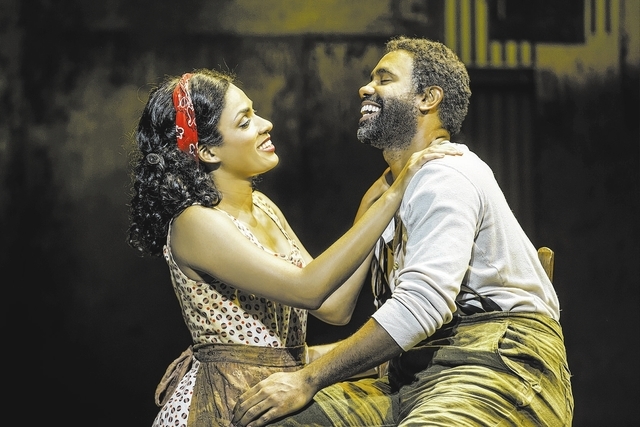‘Porgy and Bess’ brings Gershwin classic to life for modern audience


Some people consider classics sacrosanct, set in stone — and static.
But it ain’t necessarily so — as demonstrated by the Tony-winning revival of “Porgy and Bess,” which checks into The Smith Center’s Reynolds Hall Tuesday for an eight-performance run.
Since its 1935 debut, George Gershwin’s self-described “folk opera” — written with brother Ira Gershwin and DuBose and Dorothy Heyward — has become an acknowledged masterwork for its sublime musical score.
Like many “Porgy and Bess” admirers, Tony-winning director Diane Paulus — artistic director of Actors Repertory Theatre in Cambridge, Mass., where this “Porgy” originated — first experienced it as an opera. (If ART sounds familiar, it should; it’s co-producing the world premiere of The Smith Center’s “The Tempest,” continuing through April 27 in Symphony Park.)
Paulus saw “Porgy and Bess” at the a New York City Opera — “the first and only time” she’s experienced it solely as an audience member — and “fell in love with it,” she recalls in a telephone interview. “I put it on my wish list of operas I wanted to direct” someday.
But the Gershwin and Heyward heirs had other ideas, wanting a “Porgy and Bess” production that was “more of a musical,” she says.
For one thing, “on a very practical level, the opera, when done uncut, is almost four hours long,” Paulus says. (George Gershwin cut 45 minutes during “Porgy and Bess’ ” out-of-town debut in Boston, she adds.)
The Gershwin heirs wanted “a musical for the 21st century,” says Diedre L. Murray, a cellist and award-winning composer (“Running Man”), who adapted the score for the production, which won a Tony for best musical revival after it transferred to Broadway following its ART run.
After all, “culture changes, music changes, tastes change,” Murray adds, noting how the show’s “musical point of view” shifted “very subtly” during the creative process to reflect some of those changes.
One key alteration: the depiction of the musical’s setting, Catfish Row, a fictional slum in Charleston, S.C.
Catfish Row may have been based on Charleston’s Cabbage Row, but details of the slum and its residents were filtered through the sensibilities of its white creators: the Gershwins, American-born sons of Russian Jewish immigrants, and “aristocratic Southerner” DuBose Heyward, Paulus says. “The world changes. Flash forward 75 years, and their attempt at communicating that culture is dated.”
In their new production, Paulus and her collaborators — including Murray, Pulitzer Prize-winning playwright Suzan-Lori Parks (“Topdog/Underdog”), who adapted the libretto, and choreographer Ronald K. Brown — were determined to avoid the “greatest hits” syndrome, alternating scenes with such musical standards as “Summertime,” “I Got Plenty of Nothing” and “It Ain’t Necessarily So.”
In part, that’s because “so much of the most glorious music” is found in the recitative, the simpler musical passages that move the opera’s action forward between the more elaborate arias, Paulus says.
As a result, this “Porgy’s” creative team “worked quite intensely — bar by bar, measure by measure” to determine “what could be sung and what could, and should, be spoken,” Paulus says. “We weren’t following a formula. We were looking at dramatic intent, and what would feel most engaging” to modern audiences.
At an opera, “you’re letting the music wash over you,” along with experiencing the drama. In this “Porgy,” the creative team was “trying to remain true to the original intentions of the piece,” she says, likening the process to “cutting it down and sewing it back together,” keeping the focus on the story and characters.
“The power of the story is so deep,” she observes, citing “those characters and those struggles.”
The gentle Porgy (played by Nathaniel Stampley) struggles with his disabled leg, to say nothing of his seemingly hopeless affection for the troubled Bess (Alicia Hall Moran), while Bess is under the spell of the brutish Crown (Alvin Crawford) — and the “happy dust” peddled by sly mischief-maker Sportin’ Life (Kingsley Leggs).
Citing “the power of unlabeled love” between the title characters, Paulus notes that Bess has been branded “the liquor-guzzling slut ever since she walked into Catfish Row,” while Porgy’s always been “a cripple,” to use the vernacular of the times.
These “two most unlikely” lovers see each other without the restrictive branding, she adds — and “that impacts the community,” showing how “the community grows and changes” because of it.
In turn, Paulus says, “I’ve witnessed audience after audience shaken to the core” by their relationship — and “Porgy and Bess” as a whole.
While adapting Gershwin’s music, “I was trying to channel Gershwin,” Murray says, describing the composer as “so far ahead of his times” in blending classical, popular and jazz elements throughout the score. “For American musicians, Gershwin was like the great-grandfather of crossover.”
Witness the many versions of “Summertime” — one of the most recorded songs ever, she says, by artists from jazz saxophonist John Coltrane to rock legend Janis Joplin.
“It’s Coltrane, it’s a pop song, it’s an aria, it’s a lullaby,” Murray says.
Beyond that, “it’s not only that ‘Porgy and Bess’ is fantastic, it’s uniquely American because of its themes,” she adds. “It’s a hybrid piece, like America.”
Perhaps that accounts for the “quite intense social, cultural and political history” (to use Paulus’ words) that “Porgy and Bess” has built up in since its Broadway bow 79 years ago.
Some members in the African-American community considered it “not authentic,” because of its white creators, the director says. And before the current production even opened on Broadway, no less a personage than Tony-winning composer Stephen Sondheim questioned some of the prospective changes — via a letter to The New York Times) that “ignited a huge conversation,” Paulus acknowledges.
“People are passionate about it,” the director says. And even with all the resulting uproar, “there’s something thrilling and exciting about it. As a theater director and producer, all we hope for is that audiences get passionate about art.”
This “Porgy and Bess” seems to inspire such reaction, Murray says, adding how many of her New York neighbors (originally from the Caribbean) “vaguely thought there was something wrong” with the show until “they went and saw it and said, ‘Oh, my God.’ ”
From Paulus’ perspective, “this is the first time I’ve been able to sit through it and actually see these characters as human beings, in a fully fleshed-out approach.”
Which is exactly as it should be, the director maintains.
During the current national tour, the cast members are “on a particular mission,” Paulus says. “ ‘Porgy and Bess’ is an American treasure — and it belongs in every nook and cranny of America.”
Contact reporter Carol Cling at ccling@reviewjournal.com or 702-383-0272.
Preview
“Porgy and Bess”
7:30 p.m. Tuesday-Thursday; also 7:30 p.m. April 18, 2 and 7:30 p.m. April 19-20
Reynolds Hall, The Smith Center for the Performing Arts, 361 Symphony Park Ave.
$26-$129 (702-749-2000, www.thesmithcenter.com)


















